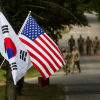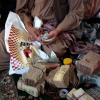
Al Qaeda is back to its old tricks in Afghanistan. Much as it did before masterminding the 9/11 attacks, the terrorist group is running militant training camps; sharing the profits of the Taliban’s illicit drug, mining, and smuggling enterprises; and funneling the proceeds to affiliated jihadi groups worldwide.
An unpublished report circulating among Western diplomats and U.N. officials details how deeply embedded the group once run by Osama bin Laden is in the Taliban’s operations, as they loot Afghanistan’s natural wealth and steal international aid meant to alleviate the suffering of millions of Afghans.
The report was completed by a private, London-based threat analysis firm whose directors did not want to be identified. A copy was provided to Foreign Policy and its findings verified by independent sources. It is based on research conducted inside Afghanistan in recent months and includes a list of senior al Qaeda operatives and the roles they play in the Taliban’s administration.
To facilitate its ambitions, al Qaeda is raking in tens of millions of dollars a week from gold mines in Afghanistan’s northern Badakhshan and Takhar provinces that employ tens of thousands of workers and are protected by warlords friendly to the Taliban, the report says. The money represents a 25 percent share in proceeds from gold and gem mines; 11 gold mines are geolocated in the report. The money is shared with al Qaeda by the two Taliban factions: Sirajuddin Haqqani’s Kabul faction and Supreme Leader Hibatullah Akhundzada’s Kandahar faction, suggesting both leaders, widely regarded as archrivals, see a cozy relationship with al Qaeda as furthering their own interests as well as helping to entrench the group’s overall power.
The Taliban’s monthly take from the gold mines tops $25 million, though this money “does not appear in their official budget,” the report says. Quoting on-the-ground sources, it says the money “goes directly into the pockets of top-ranking Taliban officials and their personal networks.” Since the mines began operating in early 2022, al Qaeda’s share has totaled $194.4 million, it says.
AFTER REGAINING POWER IN AUGUST 2021, the Taliban integrated a large number of listed terrorist groups that fought alongside them against the U.S.-supported Afghan republic. The Biden administration, however, has persistently denied that al Qaeda has reconstituted in Afghanistan or even that al Qaeda and the Taliban have maintained their long, close relationship.
Those denials ring hollow as evidence piles up that the Taliban and al Qaeda are as close as ever. The U.N. Security Council and the U.S. Congress-mandated Special Inspector General for Afghanistan Reconstruction (SIGAR) have consistently reported on the Taliban’s symbiotic relationship with dozens of banned terrorist outfits, including al Qaeda.
Few experts believed Taliban leaders’ assurances, during negotiations with former U.S. President Donald Trump that led to the ignominious U.S. retreat, that the group’s relationship with al Qaeda was over; bin Laden’s vision of a global caliphate based in Afghanistan was a guiding principle of the war that returned the Taliban regime, which one Western official in Kabul said differs only from the previous regime in 1996-2001 in that “they are even better at repression.”
The historic relationship hit global headlines when bin Laden’s successor, Ayman al-Zawahiri, was killed on July 31, 2022, in a U.S. drone strike as he stood by the window of a Kabul villa. The property was linked to Haqqani, the head of the largely autonomous Haqqani network and a member of al Qaeda’s leadership structure. He is also a deputy head of the Taliban and its interior minister, overseeing security. He is believed to harbor ambitions for the top job of supreme leader, with aspirations to become caliph.
Now that they can operate with impunity, the reports says, the Taliban are once again providing al Qaeda commanders and operatives with everything they need, from weapons to wives, housing, passports, and access to the vast smuggling network built up over decades to facilitate the heroin empire that bankrolled the Taliban’s war.
The routes have been repurposed for lower-cost, higher-return methamphetamine, weapons, cash, gold, and other contraband. Militants from Yemen, Libya, Somalia, and the Palestinian territories also circulate through the al Qaeda training camps that have been revived since the Taliban takeover. Security is provided by the Taliban’s General Directorate of Intelligence.

















